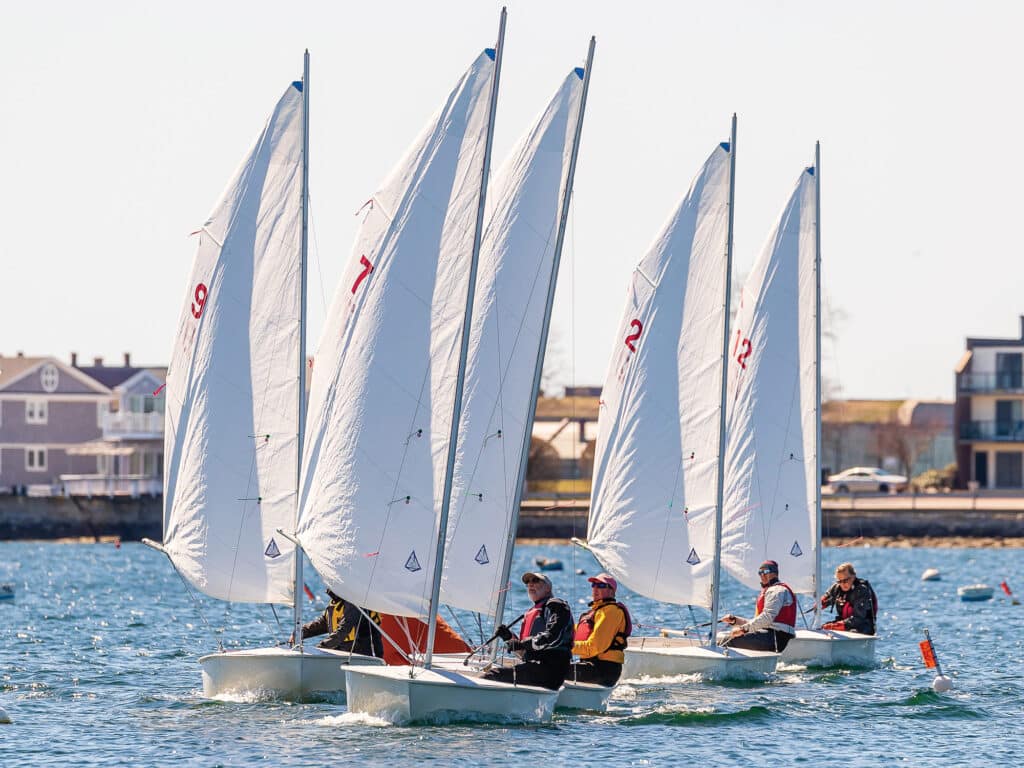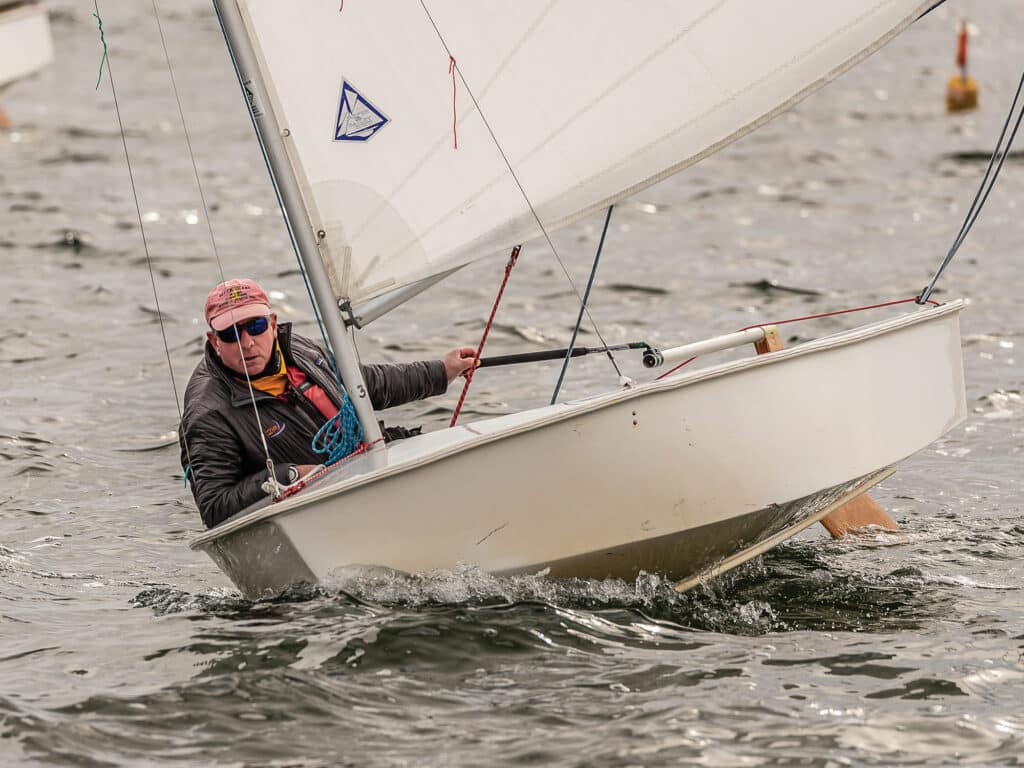
No matter how good the beer tasted on my lips or how glorious the fire-breathing spring sunset was through the windows of Newport Yacht Club’s second-floor bar, I couldn’t muster an iota of joy. If I could’ve reached my backside in this very moment, it would have been covered with shoe prints from kicking myself for doing what I can unequivocally say is the dumbest thing I’ve ever done in my 40 years of sailboat racing.
Allow me to set the scene. It’s late March and my Turnabout Frostbite season is winding down. I’m knocking on the top of the overall season scoreboard, with third or even second place mere points out of my reach. To shuffle the deck and get me there, all I have to do is pull off a few keepers. There’s no more room for a shocker, and on this fine Sunday, I’m fresh off the plane from a week of coaching at North U’s Performance Race Week in St. Thomas, where I’ve been drilling fundamentals into my students and doing the same for me by osmosis. I’m feeling sharp. I have a confident sense of purpose.
In the first prestart of this season-saving race day, I stand up in my little white dinghy at the one-minute horn and look up the course to plot my first move. The light wind is blowing out of the north, shooting unpredictable zephyrs through the buildings. I’m not a fan of the northerly, but I’ve seen this movie before, and I’ve learned the hard way too many times this season: Left is best; right is death.
The seconds tick down as I hover alone near the pin on port tack. I eat up a few more boatlengths toward the pileup near the race-committee boat, tack with 15 seconds to go, sheet in, cross the line, tack again, and point my bow at the orange tetrahedron as I cross the fleet. That’ll work just fine.
But perennial champ FJ Ritt, who has first place locked up for the season (again), is only a few lengths to leeward. We’re matching pace, straight-line sailing. Nothing to worry about. It’s just him and me. The tactics are simple: cover, cover, cover.
Round we go past the windward mark with Ritt on my tail. Same down the short run and around the bottom mark. He follows, then tacks. I stand up to take a second look at a wind line sneaking out of the harbor basin that’s near the upwind right side of the racecourse. Puff or cover? Puff or cover? I ask myself twice. Greed wins out. I hold on port and beeline to the puff. But it’s a mirage, so I cut my losses near the starboard layline to the finish. Once I tack and look under the boom, I can see Ritt charging in from the left, riding the edge of a dark wind line. Left is best, right? What the heck was I doing over here on the right. Yeah, dumb. I know.
The lesson for me here is, of course, to always confirm my finish. Listen for the horn, the whistle, the VHF or whatever means the race committee is using. And to be sure, just go ahead and sail around an end.
But it gets worse. Now I’m playing offense, and I ease my mainsheet and bear away a few degrees to close gauge and try to engage Ritt with my starboard advantage. Once I realize I’m running out of runway, all I can do is shoot the finish and hope for the best. Holding my breath, I ease the mainsheet again and glide head to wind to strike the line. All the while, I’m watching Ritt under the boom as he’s doing the same at the pin. They call his number. Nuts. Oh well, second is a keeper.
As we coast to a stop, I start jabbering with Ritt, congratulating him on a great race. Now adrift near the finish line, I notice the rest of the fleet coming in hot and in lockstep, so I bear away to clear out. As I do so, one of my fellow fleet members, who’s calling and recording finishes from the dock, hollers over and says, “Hey Dave. You haven’t actually finished yet.”
“Wait? What? No way! That’s impossible,” I protest. But who am I to question the race committee? So, I loop back around the finishers and cross behind each and every one of them before finishing for real. First to last, in a blink.

The lesson for me here is, of course, to always confirm my finish. Listen for the horn, the whistle, the VHF or whatever means the race committee is using. And to be sure, just go ahead and sail around an end. There’s also a lesson in hubris here, a lesson that the late Dr. Walker has most certainly written in a book chapter or magazine column years ago. As the good doctor would say, the pecking order is real, and Ritt is best—faster, smarter, and less likely to do idiotic things like me.
I piled on a lot of unnecessary points with that one race, which punted me a few places downhill in the standings going into the final day of the season the following weekend. Ritt was out of reach and kind enough to volunteer for race-committee duty, allowing the remaining top four—practically tied on points (decimals aside)—to fight for leftovers. A dying easterly blowing through the Newport Harbor wharves is dicey at best, but after surviving and winning the afternoon’s first race, I was confident I’d slid myself back into third overall. I could settle for that, drink my beer and be happy. Just one more race. Don’t be dumb.
With a good clean start, I’m off to the left side. I tack well shy of the port layline so I have a clean and safe entry into the mark zone, with a lot of traffic coming in from the right. I aim for a space in the lineup and tack to starboard, easily laying the mark. But coming out of the left is the one guy I’m certain I need to beat to lock third. He beat me last season, and now it’s my turn. At that moment, I’m thinking there’s no way he can complete a tack around the mark without fouling me, so just to be sure, I point straight at the buoy and shut the door nice and tight.
That was dumb. He wasn’t going to make a tack-rounding stick anyway, so me closing the door just brought us closer together. He was late ducking, and because I was sitting to leeward to induce some heel, I didn’t see the top of our masts embrace, but I sure did hear the telltale dong of aluminum on aluminum. Rigs locked, we pirouetted downwind of the mark, boats streaming past until it was only the two of us licking our wounds. There was no getting back from this disaster, and the season came to a whimpering and depressing ending. Down I slid again, fifth overall.
I’d posit Dr. Walker would offer up yet another lesson here, something along the lines of how playing offense later in the race is better, or using the rules tactically can often backfire. Of course, Walker would be right. In hindsight, I should have just kept my line into the mark and sailed my own race, and all would have been fine. That much of it bothered me later that night, tossing and turning in bed, as I do on any given Sunday night after racing, replaying races good and bad. I could have gotten around that weather mark clean, I should have not been so aggressive on shutting him out, and I would’ve ended the season on a high note.
Dumb is as dumb does, but in recent memory—short as it may be these days—I’m confident nothing tops my Doofus Dave moment quite like whiffing that earlier finish with Ritt. As I drowned my humiliation in my pale ale that afternoon, Ritt and I got a good chuckle at my expense. “I foresee a column about this,” he said with a smug chuckle.
Once again, the season champ has proven he knows my next move.









